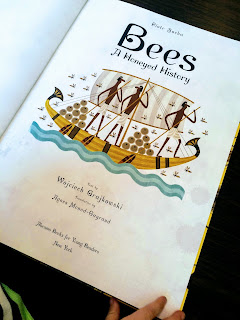By Piotr Socha
Text by Wojciech GrajkowskiTranslated by Agnes Monod-Gayraud
Published March 28, 2017
Why we chose this book:
We came across the German edition of this in the summer, though with a different cover illustration. It is the illustrations that grabbed our interest, and the description that made it clear it was the type we aim to read. Abrams Books for Young Readers provided a review copy.
Mom's Review
If you don't think learning about the history of honeybees is exciting, then you haven't seen Piotr Socha's book: an oversized picture book with striking, cartoonish figures and minimal text featuring fascinating facts.
Starting with dinosaurs, moving on to cavemen who smoked bees out of their hives, and ending with how honey is harvested and honeybees are protected today, Bees: A Honeyed History is exactly what the title suggests. T loves to flip to favorite pages, which works out perfectly, as each two-page spread covers a single topic. T's favorite pages include the carved Polish beehives page (we have now promised him that if we are ever near Kluczbork, we will see the museum's collection there), the beekeepers' tools page (he likes to pick out the tools and have me read their uses), and the Greek gods page (T likes to point out Hermes, the trickster).
T and I now both know a wee bit about bee keeping. Although the knowledge of how medieval beekeepers kept bears away from hives won't be particularly useful to us, we are inspired to plant bee friendly plants in the yard come spring, and we can use the section on their favorite flowers as a guide. We also are determined to install several honeybee houses near those flowers; this was an idea I had toyed with when we moved, but we didn't manage to do it before the snow started coming. Who knows, maybe somewhere down the road we will even manage to have a hive or two. Then we can use some of those tools T loves pointing out and asking about!
Son's Review
(Age: 3 and 1/2 years)
 Mom: Did you have a favorite part?
Mom: Did you have a favorite part?Son, pointing to Greek gods page: I did. It was this whole part.
Mom: Who is your favorite Greek god? Why?
Son: Hermes. Because I like when guys have wings.
Mom: What is something cool you learned about bees?
Son: I really liked this page [the Greek god page]. And what are they holding?
Mom: They are holding ambrosia.
Son: What is ambrosia?
Mom: It is honey.
Son: Why are they holding honey?
Mom: Because that's what they eat.
 |
| inside the car |
Son: Make bee cookies.
Mom: I have something I want to put in our garden...
Son: A bee house! Watch out. They sting!
Mom: But do honeybees want to sting us?
Son: No. When they sting, they die. They just want pollen from a flower.
Mom: For whom would this book be good?
Son: It would be good for G because bees are some yellow and yellow is a little bit orange. It is mixed with orange.
Son: Why was your favorite part that beekeepers [in medieval times] really wanted to take care of bees?
Mom: It was something new that I didn't know. I thought it was neat that the beekeepers had such an important job to take just the right amount of honey so that the bees wouldn't die.


Comments
Post a Comment